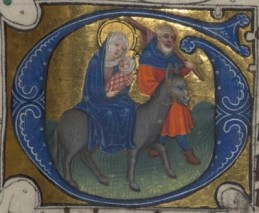
The Flight into Egypt, Walters Art Museum, MS W.188, f.112r
For the last few weeks, working from home as the world faces the COVID-19 pandemic, I’ve been Tweeting long threads about different manuscript-related subjects. But while following up on the latest thread, I made a discovery that is worth blogging about.
The thread was a brief tour of a fabulous manuscript, Berlin, Staatsbibliothek MS Theol. Lat. Qu. 140, written and illustrated by Gottschalk of Lambach in the late twelfth century.
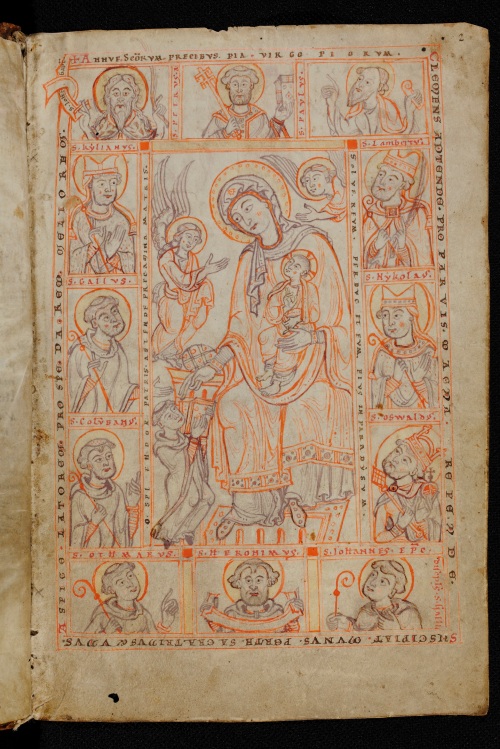
Berlin, Staatsbibliothek MS Theol. Lat. Qu. 140 (Lambach, s. XII ex)
At the end of the thread, I showed one of my favorite types of material evidence in medieval manuscripts: offsets left by manuscript fragments that were adhered to the binding structure and were later peeled away. I promised to follow up, so here goes.
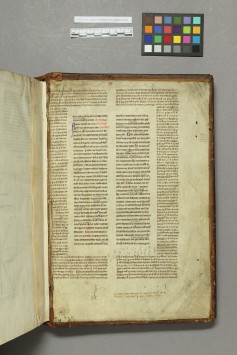
Corpus juris civilis: Institutiones Justiniani, with gloss (Oxford, Bodleian Library, A 1.11 Art. Seld.)
It was quite common in the late medieval and early modern period for binders to dismantle older or damaged manuscripts and recycle their parchment leaves for use as binding structures – covers, flyleaves, pastedowns, stays, or spine liners. These binding fragments can still be found hiding in their bindings, just waiting to be discovered. Sometimes they are removed from the binding and circulated separately, still bearing the scars of that use. The binding from which the fragment is removed can also bear the scars.
When a fragment pasted into a binding (like this one shown at the left, from Oxford) is peeled off, it may leave behind an inverted ghost-text. We have just such a situation inside the front and back covers of the Berlin manuscript.
You really can’t help but wonder about the missing fragments. When were they written? What text did they preserve? When were they peeled off? Where are they now? These are the fundamental questions a Fragmentologist asks, and I didn’t know the answers until today.
Front and Back boards, Berlin Staatsbibliothek MS Theol. Lat. Qu. 140
When faced with offsets like these, the first step is to invert the image so you can actually read the text. Here’s the front offset, inverted and in detail:
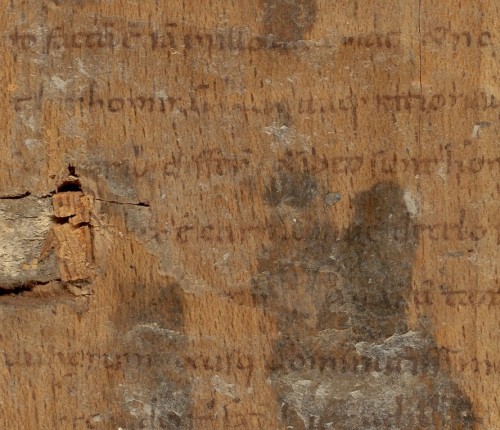
It’s actually quite legible!
Question No. 1: When and where was the fragment written? The script appears to be late tenth or early eleventh century (key features include the pointed minims of [m] and a long-[s] that drops slightly below the line of writing). These are eleventh-century fragments in a fifteenth-century binding of a twelfth-century manuscript. The binding and the manuscript are both from Lambach. What about the fragments? They are Germanic in style, but because they predate the 1056 foundation of the Lambach Abbey they must have been written elsewhere, perhaps brought to the Abbey at its foundation to stock the library.
Question No. 2: What text does it preserve? A good bit of the text is legible in the above detail: “factum est iam in illo” on the first line, “hominum” below, “ideo sunt homines” on line 3, and more. If you have access to one of the subscription collections of Latin texts, you need only plug in a few words and see what happens. During the pandemic, I’m working from home (like the rest of you), so all I’ve got is whatever is open access. Google is usually a good place to start, and, in this case, I was immediately successful in identifying the text! The phrase “factum est iam in illo” followed soon after by “hominum” and “ideo sunt homines” comes from Book IV:i of Augustine’s De Trinitate (online here):

Questions no. 3 and 4: When were they removed, and where are they now? Because I spent five years cataloguing manuscript fragments at the Beinecke Library at Yale University, I happen to know that lots of binding fragments from Lambach ended up in that collection (including seventeen leaves of the Gottschalk Antiphonal, the subject of my dissertation and first book). The Beinecke is the first place to go for anything Lambach-related, so I started there by searching for keywords “Augustine” and “Trinitate.” Bingo! Three leaves from this same manuscript are now Beinecke MS 481.20, catalogued in part by yours truly thirty years ago!
The description of the leaves, completed by curator Robert G. Babcock after I had finished my PhD in 1993, notes 1996 correspondence from paleographer Hartmut Hoffmann in which he writes that these leaves do indeed come from the same manuscript as those that were removed from the Berlin binding. What Hoffmann couldn’t have known (because he didn’t have the images), and what I just discovered TODAY, is that MS 481.20.3 isn’t just from the same MANUSCRIPT as the missing leaves, it is in fact ONE OF THEM! Folio 481.20.3 can be shown to have been pasted down inside the front cover of the Berlin manuscript. The leaf and the offset are mirror images, and f. 3r matches the visible text offset on the front board:
Beinecke MS 481.20 3r and front board, Berlin Staatsbib. MS Theol. Lat. Qu. 140
The leaf that was pasted down inside the back board is NOT at Yale, though. Hoffmann’s letter (summarized here) records that another leaf of this manuscript is still in Lambach, where it is Fragment 8/11. No images of this fragment are available, so we can’t say for sure if that’s the other missing leaf. However, using the same technique as above the offset can be identified as De Trinitate IV:v-vi, and Hoffmann identifies the text on the Lambach fragment as preserving the same section. So it seems almost certain that the leaf removed from the lower board is indeed still in Lambach.
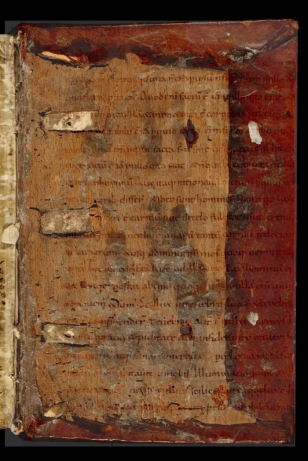
Beinecke MS 481.20.3r overlaid on the inner front board of Berlin, Staatsbibliothek MS Theol. Lat. Qu. 140 (inverted for legibility; image by Mike Toth)
As for WHEN the binding fragments were removed, I do know that part of the story because it played an important part in my dissertation research. In the 1930s, a scholar named Kurt Holter visited the Lambach library and made detailed and extensive notes about fragments in fifteenth-century bindings. When he returned to Lambach after WWII, the manuscripts were still there, but nearly all of the binding fragments were gone, most having been sold by the Abbey during the war to raise funds for necessary woodworking equipment. The Berlin manuscript was still in Lambach at that time, but the fragments had been removed and sold. From Lambach, the fragment collection made its way to Switzerland, where it was acquired in the 1950s by a dealer named Franz Zinniker. He sold the collection to NYC dealer Hans Kraus, who sold part of it to Yale in 1965 and donated the other half later that same year. By that time, the Lambach origin of the fragments had been forgotten. The story of how Robert Babcock, myself, and two other graduate students (Philip Rusche and Nancy Seybold) traced the fragments back to Lambach has been told elsewhere. This identification of 481.20.3 as having been removed from the Berlin manuscript is a poignant epilogue.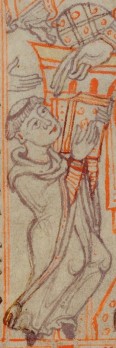
Stay safe, friends.
Bibliography:
Babcock, Robert Gary. Reconstructing a Medieval Library: Fragments from Lambach (New Haven, 1993)





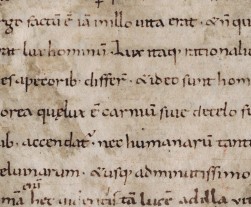

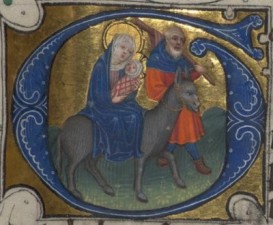







 When I first studied the Gottschalk Antiphonal in the early 1990s, I did it with scissors and paste and black-and-white photocopies on the floor of my living room. It is truly thrilling to see it in glorious IIIF-compliant interoperable color in Fragmentarium. I hope that the reconstruction will complement the liturgical, art historical, and musicological study in my book, bringing this beautiful example of twelfth-century music, liturgy, and decoration to a new generation of students and scholars.
When I first studied the Gottschalk Antiphonal in the early 1990s, I did it with scissors and paste and black-and-white photocopies on the floor of my living room. It is truly thrilling to see it in glorious IIIF-compliant interoperable color in Fragmentarium. I hope that the reconstruction will complement the liturgical, art historical, and musicological study in my book, bringing this beautiful example of twelfth-century music, liturgy, and decoration to a new generation of students and scholars.